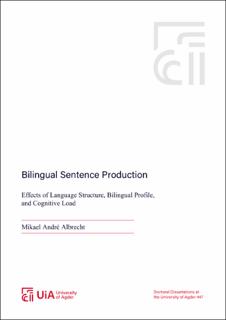Bilingual Sentence Production Effects of Language Structure, Bilingual Profile, and Cognitive Load
Doctoral thesis
Published version
Permanent lenke
https://hdl.handle.net/11250/3104999Utgivelsesdato
2023Metadata
Vis full innførselSamlinger
- Doctoral Dissertations [378]
- Publikasjoner fra CRIStin [4037]
Originalversjon
Albrecht, M. A.(2023). Bilingual Sentence Production Effects of Language Structure, Bilingual Profile, and Cognitive Load [Doctoral dissertation]. University of Agder.Sammendrag
When producing sentences, speakers plan up to a certain point prior to the onset of speech and plan the rest of the sentence incrementally while speaking. The amount planned prior to speech onset is called the planning scope. The scope of planning varies depending on both linguistic and cognitive factors. This thesis examines the preferred planning scope in bilinguals and whether it varies between languages, depending on the added difficulty of language switching, and the degree of overlap in structure between speakers’ languages. The project also examines the role of between-speaker differences in bilingual profile (e. g., language proficiency and exposure) on language production and the relationship between subjective and objective measures of these differences. The sample comprised 64 Norwegian-English bilinguals who described scenes containing moving pairs of pictures in both of their languages. These scenes were designed to elicit two different sentence structures. That is, sentences either began with an complex phrase (e. g., "[an A and a B] go up") or a simple phrase (e. g., "[An a] goes above a B"). Furthermore, structural overlap was manipulated by varying the definiteness of the sentences with Norwegian and English indefinite noun phrases being more structurally similar than definite NPs. Participants were required to switch between their languages, and participants provided subjective and objective measures of bilingual profile. Speech onset latencies and eye-fixations were recorded for each participant. The results show that participants took longer to initiate speech for complex-initial sentences and the eye-fixation data confirmed this to be due to participants planning the second noun more thoroughly on such trials. The results also reveal that the added cognitive load of required language switching reduce speakers’ lexical planning scope. Morphosyntax affected production independently of switching, but the results imply that this effect is not attributable to cognitive load. Overall, the results show that the initial phrase of a sentence modulates structural planning scope while cognitive load in the form of required language switching affects later planning processes as speakers approach speech onset.

